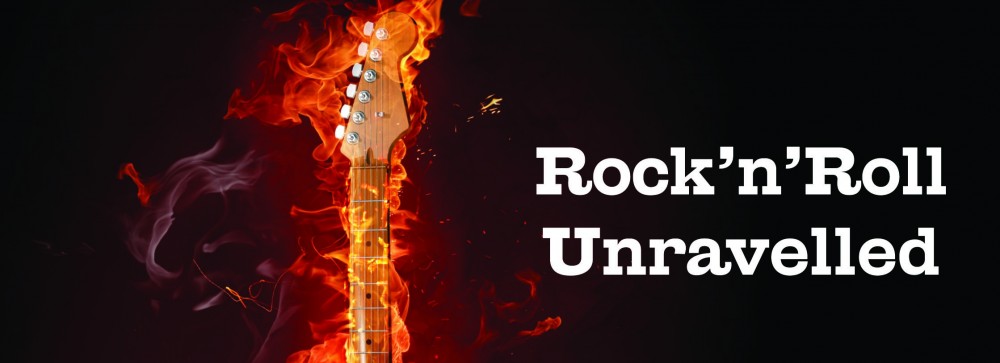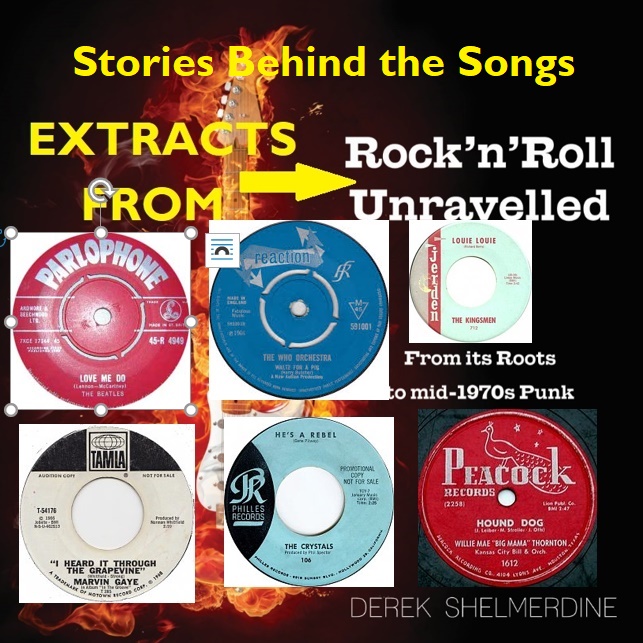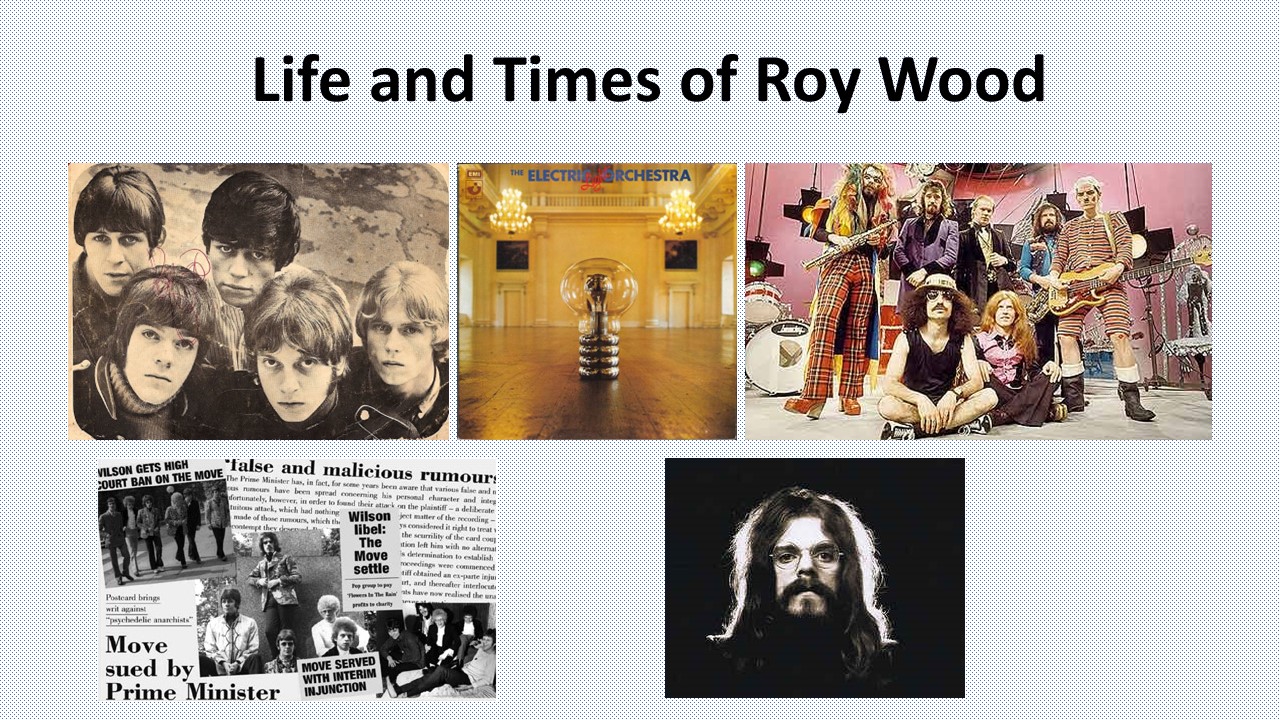Stories Behind the Songs
…all extracts from Rock’n’Roll Unravelled
Fascinating stories behind some of the greatest songs in rock’n’roll, all extracts from Derek Shelmerdine‘s book Rock’n’Roll Unravelled – the stories behind the songs
These stories are all extracts from Rock’n’Roll Unravelled
An * with a date, e.g. 26 June* 1967, indicates an associated story in Rock’n’Roll Unravelled. That story might not appear here.
Rock’n’Roll Unravelled…
…to learn more about the book
……to buy your signed and dedicated copy
………for more extracts from the book
Songs
The artist’s name against the song title is artist/band whose name is listed against the song title in Derek Shelmerdine‘s book Rock’n’Roll Unravelled.
All of the following are extracts from Rock’n’Roll Unravelled.
- He’s a Rebel – Phil Spector
- Hound Dog – Big Mama Thornton
- I Heard It Through the Grapevine – The Miracles
- Louie Louie – The Kingsmen
- Love Me Do – The Beatles
- Twist and Shout – The Top Notes (original version)
- Waltz for a Pig – The Who Orchestra
- What’d I Say – Ray Charles
…………………………………………………………………………………………
Stories Behind the Songs
These stories are all extracts from Rock’n’Roll Unravelled
An * with a date, e.g. 26 June* 1967, indicates an associated story in Rock’n’Roll Unravelled. That story might not appear here.
He’s a Rebel – Phil Spector
13 July 1962: Phil Spector recording session for He’s a Rebel
Phil Spector was back in the studio to produce his next single, the Gene Pitney penned He’s a Rebel. The song was released as the Crystals follow-up to Uptown, providing Spector’s own Philles label with its first American #1.
At that time music fans would refer to “the latest Phil Spector single” rather than the name of the recording artist. He’s a Rebel demonstrated the interchangeable nature of Spector’s acts. He had recently relocated from New York to the West Coast and this was his first recording session in Hollywood’s Gold Star Studios. The Crystals were not available at the time of recording but Spector was keen to push on because Vikki Carr was already in the process of recording the song. To fill the gap he used the talents of backing group the Blossoms, with lead singer Darlene Love. The first time that the Crystals knew about the record was when they heard it on the radio!
This song introduced arranger Jack Nitzsche to what would become a long recording relationship with Spector. Session musicians known as the “Wrecking Crew” provided the backing, including keyboard player Leon Russell, drummer Hal Blaine, guitarist Barney Kessel and with the sax solo courtesy of Steve Douglas.
He’s a Rebel was not technically the follow-up to Uptown. The Crystals had released He Hit Me (And It Felt Like a Kiss) after Uptown but the general outcry at the title and content of the song resulted in the single being quickly withdrawn.
- Original single released as The Crystals Recorded by Darlene Love
- Vikki Carr He’s A Rebel
- Uptown The Crystals
- He Hit Me (And It Felt Like a Kiss) The Crystals
Hound Dog – “Big Mama” Thornton
13 August 1952 Willie Mae “Big Mama” Thornton recorded Hound Dog
Four years before Elvis Presley took Hound Dog into the international charts, “Big Mama” Thornton recorded the original version.
This was one of Leiber and Stoller’s earliest compositions. Backing was provided by the Johnny Otis Band, Otis also produced the single. The original release gave the writing credits to Leiber, Stoller and Johnny Otis. Leiber and Stoller disputed this and by the time that Elvis’s version hit the streets, Otis’s name was no longer there.
I Heard It Through the Grapevine – The Miracles
6 August 1966: The Miracles recorded I Heard It Through the Grapevine
With Smokey Robinson, the Miracles recorded the original version of I Heard It Through the Grapevine. After hearing the Miracles recording of the Norman Whitfield and Barrett Strong song, Motown boss Berry Gordy Jr decided that it was not good enough to be released as a single. It remained in the vaults and the Miracles could only stand and watch as two of their stablemates achieved success with their versions of the song.
A little over a year later Gordy achieved chart success on both sides of the Atlantic, when he put the Gladys Knight and the Pips version of the song out as a single on his Soul label. Marvin Gaye had actually recorded a version of the song before Gladys Knight but his version was not released until the end of 1968.
Gaye’s version was by far the most successful and has become a classic of the period.
Louie Louie – The Kingsmen
30 November 1963: The Kingsmen took Louie Louie into the American charts
The iconic rock song Louie Louie moved out of the garage when the Kingsmen’s version made the American top-20 and then went on to become an international phenomenon.
The song was written and originally recorded by Richard Berry and the Pharaohs, and released on Flip in April 1957. His version made the local charts but he sold the song for few dollars in order to embark on married life. In the early 1960s the song took on a life of its own and it took him 30 years to win back the rights to the writing credit.
The Louie Louie story started in the Pacific North West in March 1961, when Rockin’ Robin Roberts released the first garage version of the song. This became a local hit in the Seattle area and the song was regularly included in local repertoires. It was in the spring of 1963 that the song’s momentum really started to build up. Two bands from the area, The Kingsmen, and Paul Revere and the Raiders, both recorded the song. The Kingsmen’s version won out and a legend was born.
The Kingsmen’s version attracted an FBI investigation to determine if the lyrics were obscene. A lengthy investigation and a 118-page report98 later – they decided not!
Radio stations have devoted entire days to playing it. Louie Louie college parties have rocked to the one song all night long. It has been covered over 2,000 times. As well as straight rock versions by the Kinks and many others, there have been ironic covers from Frank Zappa and stranger versions from the Rice University Marching Owl Band.
-
- The Kingsmen Iconic hit version
- Richard Berry and the Pharaohs Writer and original version
- Rockin’ Robin Roberts First garage version
- Paul Revere and the Raiders Recorded at the same time as the Kingsmen’s version
- Rice University Marching Owl Band
- Frank Zappa Parody version, Plastic People
Other versions include:
Love Me Do – The Beatles
6 June 1962: 1st Love Me Do recording session at Abbey Road
Shortly after returning from their third Hamburg trip, Brian Epstein secured the first recording session with George Martin, at EMI’s famous Abbey Road studios.
This was the only Beatles recording session with drummer Pete Best. They recorded four songs: Love Me Do, PS I Love You, Ask Me Why and Besame Mucho, the latter was written by Consuelo Velazquez. This Pete Best version of Love Me Do did not see the light of day until the release of Anthology 1 in 1995.
4 September 1962: 2nd Abbey Road recording session
By the time that the Beatles returned to Abbey Road for their second recording session, Ringo Starr had replaced Pete Best as the Fab Four’s drummer. Just two songs were recorded that day, Love Me Do and How Do You Do It. Producer George Martin was very keen for the Beatles to release the Mitch Murray penned How Do You Do It as their first single but the Liverpudlians were adamant that they only wanted to release their own material as their debut single.
All was not lost for Murray, another very popular Liverpool group Gerry and the Pacemakers released the song as their debut single and scored a British #1. It took the Beatles until May 1963 to hit the top spot, with their third single, From Me to You.
11 September 1962: 3rd and final Love Me Do recording session at Abbey Road Studios
Producer George Martin had not been satisfied with the second recording of Love Me Do, made on 4 September* with Ringo on drums. When the four Liverpudlians returned for their third trip to Abbey Road, Martin had secured the services of session drummer Andy White. A third version of Love Me Do was recorded, where Ringo took a backseat and played tambourine on Love Me Do and maracas on the UK B-side PS I Love You.
They also recorded several takes of another new Lennon and McCartney song, Please Please Me. This was a different arrangement to the one released as their second UK single. It was more in the style of a slow Orbison-esque ballad. Sadly, none of those takes survived for posterity.
5 October 1962: The Beatles released Love Me Do c/w PS I Love You in Britain
Three versions of Love Me Do exist, with three different drummers. Pete Best was the sticksman for the Beatles’ first Abbey Road recording session on 6 June*. By the time that they returned to the studio for the second visit on 4 September*, Best had been fired and replaced by Ringo Starr. Producer George Martin was unimpressed by Starr’s performance that day and for the third session on 11 September* he hired session drummer Andy White for the recording.
The easiest way to tell which version is being played is to listen out for the tambourine. If there is a tambourine, then Ringo is playing it and Andy White is on drums. Andy White plays drums on PS I Love You, accompanied by Ringo on maracas. Love Me Do was not released as a single in America until the Tollie version on 27 April* 1964, although it was released by Capitol in Canada on 4 February 1963.
Ironically, the initial UK release of Love Me Do had Ringo on drums. The Pete Best version did not see the light of day until the Beatles’ Anthology collection 30 years later.
27 April 1964: The Beatles released Love Me Do c/w PS I Love You in America
The ninth Beatles single to be released in America had the same coupling as the Fab Four’s British debut, released on 5 October* 1962. This, their second release on Tollie, was taken from the third Love Me Do recording session at Abbey Road, on 11 September* 1962 and featured session drummer Andy White, with Ringo sidelined to tambourine.
VINYL HISTORY OF LOVE ME DO:
1962 June 6: 1st recording session at Abbey Road – drummer Pete Best
1962 Sep 4: 2nd Abbey Road recording session – drummer Ringo Starr
1962 Sep 11: 3rd Abbey Road recording session – Andy White drums and Ringo tambourine
1962 Oct 5: UK single released – original copies (red label) with Ringo on drums
1963: released by Capitol in Canada – with Ringo on drums
1963 Mar 22: UK album, Please Please Me released – Andy White version
1963: UK Parlophone changed singles’ label from red to black – also to Andy White
1963 Jul 22: US album, Introducing the Beatles released on Vee-Jay – Andy White…
…track was replaced by Please Please Me on the re-issued album
1964 Apr 27: US single released on the Tollie label – Andy White
1965 Mar 22: 1st release in America from Capitol, The Early Beatles – Andy White
1995 Nov 21: Pete Best’s version was finally made legally available on Anthology 1
Listen for a tambourine to determine which version you are listening to!
Twist and Shout – The Top Notes
23 February 1961: The Top Notes recorded Twist and Shout
The original version of Twist and Shout was recorded in New York by the Top Notes. The song was released by Atlantic Records as the B-side of another song recorded that day, Always Late (Why Lead Me On). Phil Spector had recently joined the Atlantic Records team and in a joint effort with Jerry Wexler took this on as one of his earliest productions. The record label credited his involvement as “Supervised by Phil Spector”.
Spector was still learning his craft and was yet to develop his “wall of sound” concept. Bert Berns co-wrote the song and was very disappointed with the final version by the Top Notes. When this single failed to make any impression on the charts he took the song to the Isley Brothers at Wand. This time Berns handled the production personally, giving the Isley Brothers their first hit on both sides of the Atlantic.
The song is probably best known for the cover version by the Beatles, released in the UK on their debut album, Please Please Me. In America the song was included on their first-ever American album, Introducing the Beatles, released on the small, independent Vee-Jay label.
- The Top Notes
- The Isley Brothers
- The Beatles Legendary “rattle your jewelry” Royal Command Performance
Waltz for a Pig – The Who Orchestra
14 March 1966: The Who released Substitute c/w Waltz for a Pig (UK)
The Who’s follow-up to their classic My Generation single was also their first release on the new Reaction label. Two versions of Townshend’s Substitute were released, one with the B-side Circles, the other with Instant Party. In reality they were both the same song.
The producer of their earlier Brunswick singles, Shel Talmy, had already recorded Instant Party and he took a dim view of the Who re-recording the song for their new label. He made his point by releasing his version of Instant Party as the B-side for A Legal Matter. To right the wrong, he obtained an injunction which stopped sales and prevented the Who from recording. They rescued the situation by changing the B-side to Waltz for a Pig, performed by the Who Orchestra with a writing credit for Harry Butcher.
This new B-side was actually performed by the Graham Bond Organisation. Drummer and future Cream sticksman Ginger Baker was the writer, credited as “Harry Butcher”.
What’d I Say – Ray Charles
18 February 1959: Ray Charles recorded What’s I Say (Parts1 & 2)
This classic song had its origins in a live performance a couple of months earlier. It was late one evening, Ray Charles and his band had exhausted their repertoire but still had time to go until the end of the set. Charles told the others to follow his lead and they performed an improvised first version of What’d I Say. When he recorded the song it proved to be too long for one side but rather than edit it, Charles insisted that it was split across both sides of the single.
Charles had scored a succession of R&B hits since the early 1950s but this was his first big crossover success. The record began a string of hits that lasted into the 1970s.
The song has inspired a multitude of covers. It gave Jerry Lee Lewis a hit on both sides of the Atlantic in 1961 and Bobby Darin a US hit in 1962. Elvis scored American chart success after using the song in his fifteenth movie, Viva Las Vegas in 1964.
Rock’n’Roll Unravelled – to buy your signed and dedicated copy
More stories behind the songs – to be continued…


